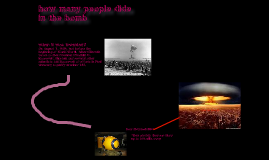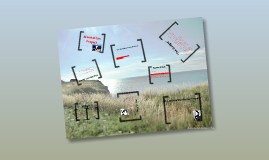Atomic Bomb
Transcript: On August 2, 1939, just before WWII started, Albert Enstine wrote to the President telling him that Nazi Germany was trying to purify uranium-235 to build an atomic bomb. Shortly after this, the United States began the Manhattan Project. The Manhattan Project This was the United State’s Nuclear program. Their main goal was to figure out how the United States would be able to use Nuclear bombs. Testing of the Gadget AKA the Atomic Bomb At last the day had come to see if the Gadget (codename for the atomic bomb) would be a great and wasteful failure or the end of WWII. Early in the morning on June 16, 1945, in the Jemex Mountains in northern New Mexico, the Atomic bomb was tested. The bomb lit the early morning sky orange and the atomic fireball shot upwards at 360 feet per second. The Mushroom cloud of radioactive vapor materialized at 30,000 feet. Beneath the cloud, all that was left after the blast were fragments of jade green radioactive glass created by the intense heat of the reaction. Citizens reaction to the secret operation No one knew that any of these tests were going on besides the government. After the bomb went off however, citizens in a neighboring community were rather confused. They thought that the sun had come up twice, that was how bright the light was from the bomb. Even a blind girl 120 miles away recognized that there was a flash. The Enola Gay was escorted by 2 other camera aircrafts and 3 other aircrafts had left a few hours before to check on the weather over possible targets. Little boy • First Atomic bomb used in combat • It had a force equal to 1300 tons of TNT • Little boy was a gun-type U-235 weapon • It was 10 feet in length • It weighted 9,000 pounds • It fired one subcritical piece of U-235 into another which caused a nuclear chain reaction. The Bockscar carried Fat Man, the atomic bomb that was dropped on Nagasaki. On August 9, The B-29 Aircraft took off from Tinian with the second and last atomic bomb. Bockscar only had enough fuel to drop the bomb and quickly come back. The bomb was dropped at 11:00 AM ending the war with Japan. Because of the fuel being so low, on the way back, they stopped in Okinawa to re-fuel and continue to Tinian. Fat Man • Fat Man weighed 10,000 pounds. • It had an explosive capacity of 20,000 tons of high explosives. • Fat Man was 10 ft and 8in long. • Unlike Little Boy, Fat Man used the implosion method. It had a circle of 64 detonators that shot bits of plutonium together with supercritical mass. On August 6, 1945, Hiroshima was having a clear (weather) day. At 8 AM, Enola Gay’s doors opened and dropped "Little Boy". Captain Robert Lewis, the co-pilot said, “Where we had seen a clear city two minuets before, we could no longer see the city. We could see smoke and fires creeping up the sides of the mountains”. “Two-thirds of Hiroshima was destroyed. Within three miles of the explosion, 60,000 of the 90,000 buildings were demolished. Clay roof tiles had melted together. Shadows had imprinted on buildings and other hard surfaces. Metal and stone had melted. Unlike many other bombing raids, the goal for this raid had not been a military installation but rather an entire city. The atomic bomb that exploded over Hiroshima killed civilian women and children in addition to soldiers. Hiroshima's population has been estimated at 350,000; approximately 70,000 died immediately from the explosion and another 70,000 died from radiation within five years." (Rosenberg, Jennifer. Hiroshima and Nagasaki. N.p., n.d. Web. 25 Mar. 2012. <http://history1900s.about.com/od/worldwarii/a/hiroshima.htm>.) There were 4 choices of cities to drop the atomic bomb on, Hiroshima, Kokura, Nagasaki, and Nigata. These cities were chosen due to the fact that they had been untouched through out the war. The Enola Gay The Enola Gay was a Modified B-29 aircraft. It was modified because it would need to be able to carry “Little Boy” the atomic bomb. It had new propellers, stronger engines and faster bomb opening doors. The end Thanks for watching Pictures after the bombing This is all that was left of a person on the side of a bank who was incinerated by the incredable heat. The heat was so intense that practically everything was vaporized. Those shadows were all that was left of the people sitting there. The Making of the Atomic Bomb The most difficult part of creating the atomic bomb was the fact that it used U-235. This was incredibly hard to extract because of the fact that 99% of uranium is U-238 which is useless. A huge plant was constructed at Oak Ridge, Tennessee. Harold Urey and his helpers at Columbia University made an extraction system that worked on the principle of gaseous diffusion. This device separated lighter U-235 from the heavier non fissionable U-238. After this, all that would be needed would be to test the concept of the atomic fusion (splitting an atom). During the course of the next 6 years, (1939-1945) the United States donates more than $2 billion to the

















